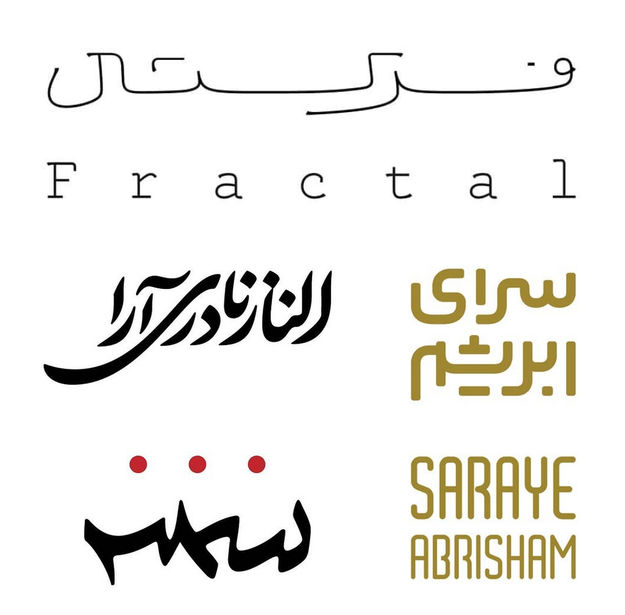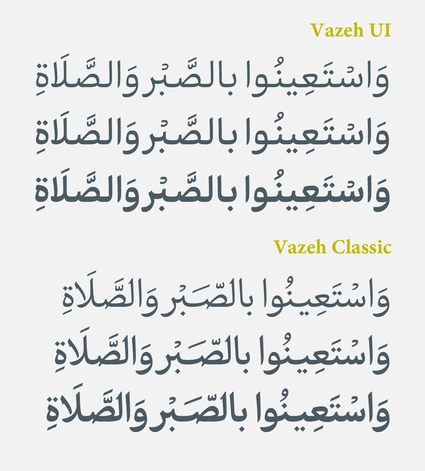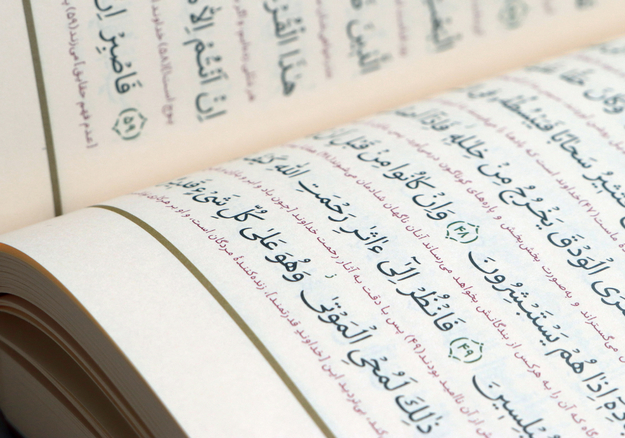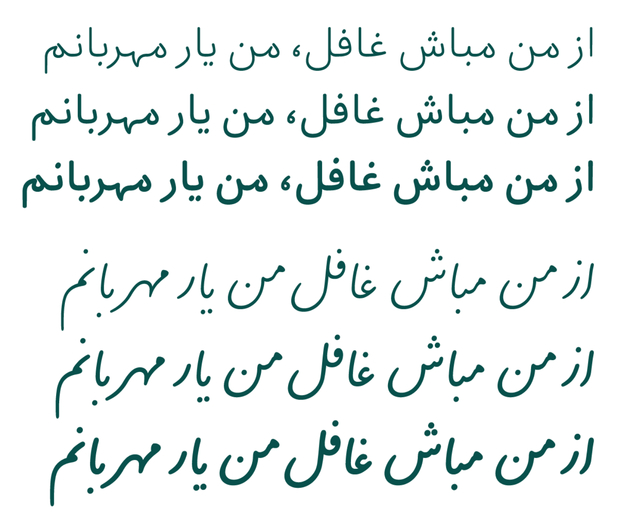Exceptional position
Iran stands out from the rest; it calls itself now the Islamic Republic, putting literally religion at its cultural and political centre. The Nastaliq style was invented in Iran. Mir Ali Tabrizi, is credited for organising and systematising this script style. Iran has an exceptionally rich tradition in graphic design and other applied arts. Oddly enough, and by contrast, up until very recently, there was no type design culture to speak of. All famous Iranian poster designers seem to use the same font, as if only one font was available. . All children in Iran are taught how to write in two Arabic calligraphic styles: Naskh for beginners, followed by Nastaliq for the more advanced classes. In other Arabic countries the Ruqa style is often used for this purpose, because of it’s the simplest way to write Arabic. Traditional calligraphy is still taught widely in Iran. Calligraphic knowledge is considered mandatory for type designers, and several religious institutions try to reach the public using social media. Iranian type designers make extensive use of Western social media like Behance and Instagram, just like almost every other designer on the globe. So next to learning two scripts, Iranians must also deal with the Latin script. Tourists from abroad travel around in Iran and many Iranian businesses carry logos using the Latin script. All designers use social media with English text, so Iranians have to learn how to read and write in the Latin script as well. The majority of their clients are Iranian, but designers want to expand outside of their country. The world has become international for everyone and the world speaks English. Moreover, most publications on design are in the English language, so also Iranian designers have to understand the English language in order to stay informed. Understanding these specific situations are important to comprehend the current position of type designers in Iran.
Reza Bakhtiarifard:
“In 2014 I got a BA in graphic design at the EITTC or Enghelabe Eslami University. Type obviously plays an important part in this profession and I felt a more that average attraction to playing with letters. In 2012, I studied the Moalla calligraphic style (a calligraphic style invented by Hamid Adjami in 1999). There was no specific reason to study this style, I just felt attracted to the letter shapes. Later, I took calligraphy courses to learn the more classical calligraphic styles like Thuluth (2013) and Nastaliq (2017). I chose Thuluth style more consciously. Thuluth is a beautiful and efficient style; it has a wide variety of forms, displays strength and charm, and has great compositional power. Learning Thuluth increased my design abilities dramatically. Nastaliq was attractive to me as a style because it has an Iranian spirit. I wanted to find out where the ‘Iranian look and feel’ is in letter shapes. I learned about the Thuluth style through the Calligraphers Association. This organisation does not work with master calligraphers, but rather with professional instructors, who each holds different levels of grade. Instructors with the highest grade teach the highest level students.
Traditionally, you learn calligraphy by working under a master calligrapher. Studying with a master calligrapher is only for students who wish to become professional calligraphers themselves. Calligraphers are considered artists not crafts people, whereas other instructors simply provide detailed information about calligraphic styles.”
Type design courses
“In 2014, I also took a course in type design with Damoon Khanjanzadeh. He taught in the Vije Art School outside of the university. Before going to that course, as part of my study, I was a trainee at MaryamSoft and was familiar with font design. Damoon’s class was at the time the only specialized course in type design. What I learned from that class was first, the importance of calligraphy and reference to calligraphy in type design; second, the basics of designing a formal font; and third, how to make better use of paper and pen because making sketches by hand is an important part of the font design process. I was Damoon's student for many years and I was later responsible for producing his font files.”
“Damoon has certainly put type design on the map in Iran. Before him there were very few capable font designers, like Hossein Abdullahzadeh Haghighi, Mohammad Reza Baghapour, Mostafa Oji, Assadollah Chehre Pardaz. The strength of Damoon’s own recent font designs is that he takes type design away from calligraphy and turns it into genuine type. Of course type and calligraphy share the same origins, but each have a very distinct functionality that determines the shape of letters. Lettering has a functionality somewhere in between. I think in the near future in Iran and other Arab countries, younger designers and my peers will give new life to this trend of focussing on pure typographic functionality in font design. Both in terms of quantity and quality.”
Two major type design commissions
“I design fonts for companies, institutions, and for the font foundry MaryamSoft. I also design logotypes, in commissions from ad agencies, art directors, or directly from companies. Two major type design commissions I worked on were: one for a religious institution, the Ofogh-e Rooydaad Group, and the second for MaryamSoft, a font vendor, that decided a special font was needed for textbooks produced by publishers of educational materials.
Second logo from to top and left:designed by Reza Bakhtiartifard in collaboration with Omid Emamian.
Second logo from to top and right: designed by Reza Bakhtiartifard in collaboration with Mitra Shahsavand design studio.
The first client wanted two new font designs to be used for producing contemporary looking Qurans. One font was for print: the original text in Arabic and underneath it the translation in Farsi. The second one was for screen presentation. Both fonts were used, only for print so far. The font originally designed for screen was in principle aimed at a younger target group than the other font designed for print.
The second commission, as with the first one, I did in close collaboration with Omid Emamian. In this case also two font designs were needed, each for a basically different use. The fonts were for text books to be used in schools to teach children how to write and read Farsi. For the lower classes in the Naskh style, for the advanced students in the Nastaliq style. I must say that to do this right, we did a lot of research, came up with different ideas, interviewed several people: Persian and calligraphy teachers Kamran Ansari (textbook font designer) and Abdolrahman Saffarpour (an old author of Persian textbooks). This latter was in charge of developing school textbooks before teaching Nastaliq became mandatory in school’s curicula. He is also fundamentally against the idea of teaching young kids how to write in the Nastaliq style. In the end, a conclusion was reached that learning how to write in two different calligraphic styles for general education is instructive, but how to design the fonts in the simplest possible way needed a lot of consideration. None of these fonts are in use yet.”
Dabestan font family designed for a textbook that teaches children in Iran the two mandatory type styles: Naskh (for beginners) and Nastaliq (for higher classes).
Databestan Font: Comparison of proportions of the Nastaliq and the Naskh styles.
Starting my own design course
“During my career I was only employed for very short periods of time. So I always had my own design practice. I taught myself everything that was missing from my schooling. Most graphic designers in Iran are hired by Ad agencies or directly by companies as in-house designers. Type designers have their own studio. But freelancing and small independent design practices are on the rise.
Poster for Reza’s type design workshop designed by Hamed Kasaei Nasab. -
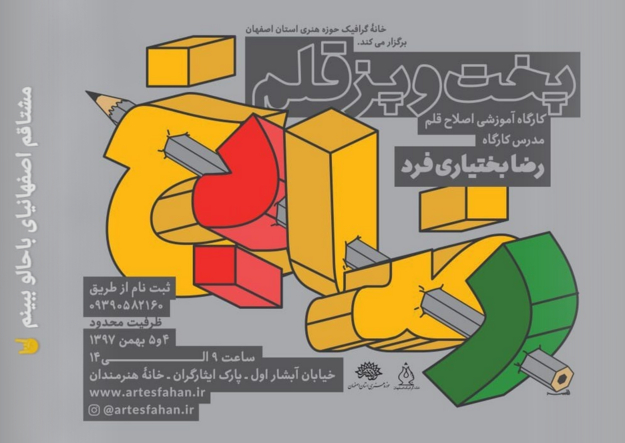
Luckily, companies and organisations are now interested in developing their own corporate fonts. For some commissions I collaborate with other designers, but I produce myself my font files. I consider myself a designer who creates functional fonts, strictly following my client’s brief. The links with calligraphy is important to me, however, I do not see myself as a calligraphy master or artist. Not yet.”
“My knowledge and experience is not enough to be able to teach calligraphy, but so far I have given three font design courses. A total of about 30-35 students register for my courses. I also have started an online course recently in which lessons are recorded and students see the lessons and submit exercises. There are more students in this course and they are increasing. The interest in learning font design has dramatically increased in Iran and I believe it will continue to do so.”
